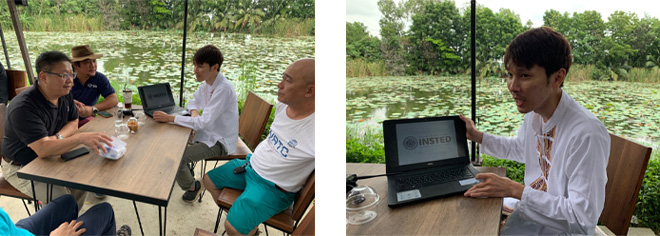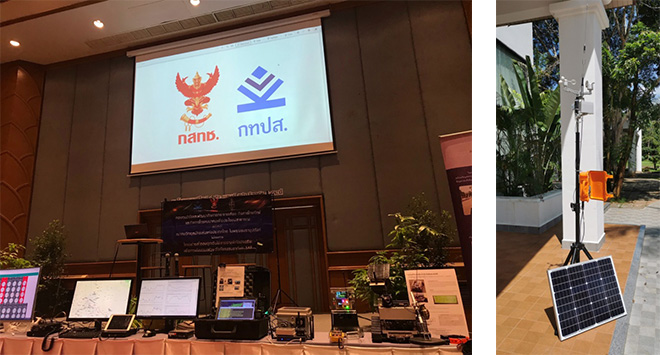Report from Thailand
RAST HF-101, November RAST meeting
On 18th October 2020, The Radio Amateur Society of Thailand (RAST) under the Royal Patronage of His Majesty the King, held “The 3rd HF-101 Seminar” via a zoom meeting for the new HAM members.

The topics of the seminar include:
- “Rules, regulations, common practices and ethics on the HF bands” was lectured by Mr. Pornchai Semjang (Joe), HS2JFW
- "Understanding of HF propagation” was introduced by Mr. Kriangkrai Suriyakrai (Choon), E20HHK
- “Different HF modes such as CW, SSB and digital”. And “devices for instance, transceivers and antennas required to set up a new HF station” were explained by Mr. Nikorn Deesai, HS5NMF
- “DXing, Contesting, Logbook, LoTW, DXCC, and QSLing” was detailed by Mr. Champ C. Muangamphun, E21EIC


RAST president Dr Jakkree Hantongkom (Jack), HS1FVL started the seminar with an opening speech at 09:00. Over 40 participants and lots of interesting questions were raised during the two Q&A sessions, in particularly about the types of antennas to be used and the availability of HF propagation prediction tools on the internet. For many, this seminar serves as a steppingstone for those who have just upgraded from the Fundamental Certification to explore new experience further for VHF and local contacts. The new acquisition of knowledge may help them to operate new HAMs more profoundly. So they can use HF bands to send out messages not just locally but across the World.

November RAST meeting
RAST conducted a monthly meeting on 1st November 2020 at Baan ImSaBuy at a restaurant in Bang Bua Thong District of Nonthaburi, the northwestern suburbs of Bangkok. The meeting was taken place in an outdoor environment to avoid any risk of contracting COVID-19.

Dan, HS0KRM and Jack, HS1FVL President of RAST
The turnouts were relatively low, there were around 25 members attended the event in the end. The President of RAST, Dr. Jakkree Hantongkom (Jack), HS1FVL announced that it is important for RAST to maintain co-ordination with the King Mongkut Institute of Technology North Bangkok on the space program. He also appointed Mr Apiwat Jirawattanaphol (Pao), HS4SCI, a former space engineering student, as the main coordinator and representative for RAST.

Pao, HS4SCI, RAST tomaintain co-ordination with the King Mongkut Institute of Technology North Bangkok on the space program.
The Broadcasting and Telecommunications Research and Development Fund for Public Interest (BTFP) is responsible for the “Summary of Budget Allocation for 2020”, who also authorized to permit 85 Projects, as well as an inspector for “Automatic Weather Station Prototype” that developed by The Radio Amateur Society of Thailand (RAST) under the Royal Patronage of His Majesty the King.

On 5th November 2020, at Maritime Park & Spa Resort, Khao Kanab Nam, Krabi, Tara Conference Hall, The Broadcasting and Telecommunication Research and Development Fund for Public Interest (BTFP) and relevant authorities jointly announced the budget allocation for 2020 was decided to support 85 projects that are for public interests. BTFP also performed an on-site inspection and test out the “Automatic Weather Station Prototype” that developed by The Radio Amateur Society of Thailand (RAST) under the Royal Patronage of His Majesty the King, as one of the projects which received the funding under Type 1/2018, the project was titled “Backup Wireless for Emergency Communication with Co-ordinates and Intelligent Network for the Monitoring and Prevention of Natural Disasters and SAR”. Relies on the use of radio frequencies and hi-speed Internet to create a real-time weather monitoring system that has the capability to support governmental agencies thatmanage and prevent natural disasters, to locate search and rescue team, and to help farmers plan their cultivation. Also, the weather patterns are becoming increasingly unpredictable in Thailand, these technologies play a vital role in preventing any damages that may occur in the future. This Automatic Weather Station has indeed passed the performance test and have reached the standards set forth by RAST. These 40 stations have already been installed across Thailand.

Mr. Nipon Jongvichit, Director of BTFP revealed, under the direction and regulations of Thailand by the National Broadcasting and Telecommunications Commission (NBTC), in order to drive innovation and research in the broadcasting and telecommunication sector to benefit public, economy, and society, BTFP aims to promote and support the use of radio frequency spectrum to its full potential through budget allocation to various departments.

Dr.Jakkree Hantongkom, HS1FVL, president of RAST, researcher and head of the project added, the Automatic Weather Station involves 4 main components:
1. I-Gate WX station to pull together the statistics and any attached data from each province
2. Sensors that are appropriate for each area, which then forward the data to the receiving station
3. Antenna equipped on the VHF band at 144.390 MHz
4. Cables, power source, and all the connectors involved

The sensors are responsible for taking the measurements at 10-minutes intervals.
The data are sent from the sensors to the I-Gate WX receiving station, which in turn forwards the information to the central hub for collection.
The data can then be processed and analysed, also displayed as required.

In general, the information gathered from these stations can be applied in 3 main contexts:
1. Aid the government in the management and prevention of natural disasters - The system will continuously report natural statistics in real-time via sensors across all regions of Thailand. Such data includes temperature, humidity, air pressure, rainfall, wind direction, and PM2.5 pollution level. All these data function to serve the general public, civil and government agencies, in monitoring, surveillance and prevention of natural disasters especially in remote areas, through the use of VHF which is not limited by geographical features, and whose data can be viewed graphically for easy understanding and implementation. The general public can gain access to these data and adapt their lives accordingly at no additional expenses.

2. Pinpoint search and rescue in real-time – The system will processed the geographical data and pinpoint the search in real-time in the form of blinking red light in the program, whereby it is able to differentiate between different objects such as human, cars, planes, boats and other vehicles, as well as track the movement in all areas, the information of which can be reach via the internet from anywhere in the world. Users can set the scope, and use the information gained to plan the rescue mission in real-time and adapt to the situation as necessary without having to be on-site. This is especially useful if the emergencies are being handled by generals or commanders who must issue orders from far away but need a good overall understanding of the situation for careful planning and coordination.

Nimit, HS1IFU, Engineer and system designer; Mr. Nipon Jongvichit, Director of BTFP: Dr. Jakkree Hantongkom (Jack), HS1FVL President of RAST

Dr. Jakkree Hantongkom (Jack), HS1FVL President of RAST presents the Automatic Weather Station.
3. Help the farmers to plan their cultivation and harvest – The system will display important information related to cultivation such as rainfall, soil moisture content, water level in the river or canal, wind speed, and weather conditions. These data can be kept as history records for future extrapolation if required. The information gained can also aid Smart Farming and help the farmers to plan the timing of future harvest. In addition, it can also serve to track the efficacy of the Royal Rain project for future flights management.

RAST’s project Staff: HS5NMF, E21FYK, HS1IFU, HS0KRM, HS1FVL, E23NEZ
Report from Thailand backnumber
- A Visit to Tohoku in Japan
- JARL Ham Fair 2024
- N5J Jarvis Island DXpedition 2024
- HS72KING
- Vacharaesorn Vivacharawongse Elected as RAST Honorary Advisory Chairman, RAST Organized E2QRP for 2024 IARU QRP Day, etc.
- Recap from 5 years ago, Vivacharawongse Visited HSØAB, US FCC Amateur Radio License Examination
- RAST Celebrated its 60th Anniversary and Held 2023 AGM in Saraburi Province
- Krabi ARDF 2024 for HRH Princess Maha Chakri Sirindhorn Royal Cup
- E20AX/P IOTA DXpedition to Lipe Island (AS-126)
- December YOTA Month in Thailand
- CQ World Wide DX Contest from Thailand
- IARU R3 YOTA Camp Pattaya, Thailand
- Dxpeditions, US FCC Examination, CQ World Wide DX Contest 2023, etc.
- JA Hams visited E20AX Club Station
- JARL HAM FAIR 2023
- World Radiosport Team Championship WRTC 2022 (2023) Bologna, Italy, 4-11 July 2023
- Friedrichshafen Ham Radio Fair 2023
- Parks on the Air in Thailand
- RAST on The Beach 4
- Fred Laun K3ZO Silent Key (Part II) A great loss for amateur radio
- Fred Laun K3ZO Silent Key (Part I) A great loss for amateur radio
- HF Amateur Radio Seminars Hosted by RAST and NBTC BW/E25KAE, The First Thai HAM Operator in Taiwan
- CQ World-Wide DX Contest SSB & CW 2022 from Ban Ta Bong (The Center of the World)
- POTA Activations in Thailand by JJ1DQR,
Advanced Class Examination for Thai Amateur Radio Licenses - HS3NBR/p Maeo Island IOTA AS-145,
16th – 19th September 2022 - JARL HAM FAIR 2022
- Inmemoriam to the former RAST President Mayuree Chotikul, HS1YL,
US FCC Amateur Radio License Examination in Thailand, etc. - 45th International Amateur Radio Exhibition in Germany“HAM RADIO FRIEDRICHSHAFEN 2022”
- E20AX/P Mini-IOTA DXpedition to Samet Island (AS-107)
- Easing of Travel Restrictions for Visitors Entering Thailand,
Tribute to Franz Langner, DJ9ZB and Roger Western, G3SXW - RAST held its General Annual Meeting, May you rest in peace JH1AJT and W7LR
- RAST Annual General Meeting, March 20, 2022
- The First Intermediate License Examination Since COVID-19 Outbreak
- E20AX/p IOTA DXpedition to Chang Island (AS-125)
- CQ World Wide DX Contest CW 2021 from Thailand
- CQ World Wide DX Contest SSB 2021 from Thailand
- The 18th IARU Region 3 Virtual Conference was a success
- Celebrating 400th anniversary of trade relationship between Denmark & Thailand, etc.
- E2HQ RAST Headquarter 2021, etc.
- RAST will host the IARU Region 3 Conference 2021 online in September, etc.
- RAST Talks, RAST CW Challenge Results
- RAST held AGM meeting and hosted New Year Party, NARIT Astro Fest 2021
- RAST CW Challenge
- KMUTNB and RAST welcome Minister of Higher Education, Science, Research and Innovation & other news.
- FCC Amateur Radio License Exam, RAST Donated a Tower to Huai Kha Khaeng Wildlife Sanctuary,Installation of 2EL Quad at E24OYI
- RAST & G. SIMON BALLOON FESTIVAL 2020 "E2ICOM"
- RAST HF-101, November RAST meeting
- NBTC and RAST presented the callsign HS10A to His Majesty the King
- RAST hosts August meeting at an open-air restaurant
US FCC Amateur Radio License Examination at KMITL, Bangkok, Thailand - E2HQ RAST-Headquarter, Spirit of the 2020 IARU HF World Championship
Installation of E24EZ, The first DMR Repeater in Thailand - Global COVID-19 “STAYHOME” Radio Communication Event was a great success
- E2STAYHOME, RAST COVID-19 Special Event
E21EIC inducted into CQ Amateur Radio Hall of Fame
COVID-19 RADIO COMMUNICATION EVENT - The E21EIC Station Antenna System Improved for Competition
- RAST Annual General Meeting
April RAST meeting cancelled, YOTA event is postponed - RAST installs IGATEs to expand the APRS network in Thailand
- First US FCC Amateur Radio License Examination in 2020
- Thailand Amateur Radio Day 2019



